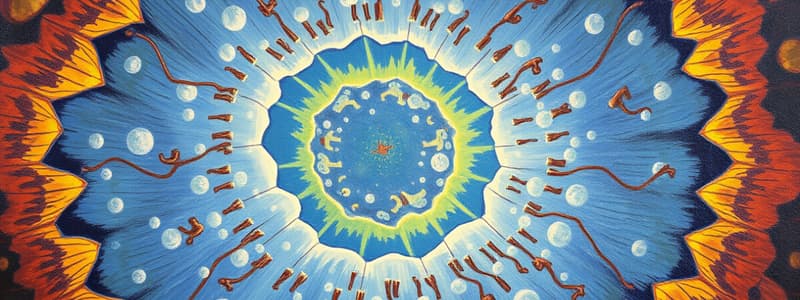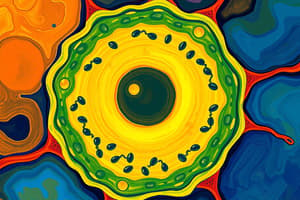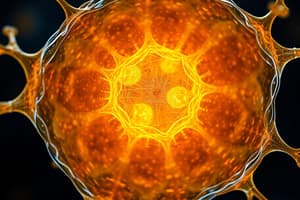Podcast
Questions and Answers
What is the primary function of the plasma membrane?
What is the primary function of the plasma membrane?
- Produces ribosomes
- Control movement of substances in and out of the cell (correct)
- Processes metabolic energy
- Storage of genetic material
The nuclear envelope is a single-layer membrane that encloses the nucleus.
The nuclear envelope is a single-layer membrane that encloses the nucleus.
False (B)
What is the genetic material found within the nucleus called?
What is the genetic material found within the nucleus called?
DNA, arranged in chromatin
The plasma membrane is composed of a _____ bilayer.
The plasma membrane is composed of a _____ bilayer.
Match the following components with their functions:
Match the following components with their functions:
What type of proteins penetrate the hydrophobic core of the lipid bilayer and often span the membrane?
What type of proteins penetrate the hydrophobic core of the lipid bilayer and often span the membrane?
Cilia are long, whip-like structures used for motility in human cells.
Cilia are long, whip-like structures used for motility in human cells.
What are the primary components of a plant cell wall?
What are the primary components of a plant cell wall?
The __________ is known as the powerhouse of the cell.
The __________ is known as the powerhouse of the cell.
Match the following organelles with their primary functions:
Match the following organelles with their primary functions:
Which of the following structures contains digestive enzymes?
Which of the following structures contains digestive enzymes?
The rough endoplasmic reticulum (RER) is involved in lipid synthesis.
The rough endoplasmic reticulum (RER) is involved in lipid synthesis.
What is the function of histones in DNA organization?
What is the function of histones in DNA organization?
The __________ is where the Calvin cycle occurs in chloroplasts.
The __________ is where the Calvin cycle occurs in chloroplasts.
Match the following structures with their materials:
Match the following structures with their materials:
Which component of the cell membrane is responsible for maintaining its shape?
Which component of the cell membrane is responsible for maintaining its shape?
Vacoules are primarily involved in protein synthesis.
Vacoules are primarily involved in protein synthesis.
What is the function of the smooth endoplasmic reticulum?
What is the function of the smooth endoplasmic reticulum?
The process of converting sunlight into chemical energy in sugars is known as __________.
The process of converting sunlight into chemical energy in sugars is known as __________.
Flashcards are hidden until you start studying
Study Notes
Cell Composition and Structure
- Nucleus: Control center, separated by nuclear envelope, contains DNA in chromatin form.
- Plasma Membrane: Lipid bilayer, selectively permeable, maintains homeostasis, controls substance movement.
- Endomembrane System: Includes nuclear envelope and rough/smooth endoplasmic reticulum, facilitates intercellular transport.
Membrane Components
- Phospholipids: Abundant in plasma membrane, amphipathic properties, essential for membrane structure.
- Integral Proteins: Span the lipid bilayer, play a role in transport and signaling.
- Peripheral Proteins: Loosely attached to membrane surface, involved in signaling and structural support.
Organelles and Their Functions
- Ribosomes: Non-membrane-bound; essential for protein synthesis, can be free or attached to rough ER.
- Rough Endoplasmic Reticulum: Studded with ribosomes, synthesizes and modifies proteins, involved in membrane synthesis.
- Smooth Endoplasmic Reticulum: Lacks ribosomes, synthesizes lipids, detoxifies compounds, stores calcium.
- Golgi Bodies: Packages and processes proteins from rough ER; modifies proteins and lipids for transport.
- Lysosomes: Contain digestive enzymes for breaking down waste and cell renewal processes.
Energy-Related Organelles
- Mitochondria: Known as the powerhouse, produces ATP from fats and carbohydrates through cellular respiration, double membrane structure.
- Chloroplasts: Photosynthetic organelles in plant cells, convert sunlight into sugar; have a double membrane and stroma for Calvin cycle.
Extracellular Components
- Cilia and Flagella: Aid in cell motility; cilia are short for moving substances, while flagella are long, whip-like structures found on sperm.
- Cell Walls: Present in plants (cellulose), fungi (chitin), and archaebacteria (pseudomurein); protect cells and maintain shape.
Cytoskeleton
- Composition: Network of protein fibers including microfilaments, intermediate filaments, microtubules.
- Function: Provides structural support and aids in cell movement and transport.
Vacuoles
- Prominent in plant cells, serve multiple functions including storage, waste breakdown, and hydrolysis of macromolecules.
Plastids
- Types and Functions:
- Chloroplasts: Photosynthesis.
- Amyloplasts: Store starch.
- Chromoplasts: Contain pigments for color.
- Elaioplasts: Store lipids.
- Proteinoplasts: Store proteins.
Genetic Material
- DNA/Chromosomes: Each chromosome consists of long DNA molecules associated with proteins (histones), important for genetic information storage.
Comparison: Prokaryotes vs. Eukaryotes
- Prokaryotes lack a defined nucleus and membrane-bound organelles, whereas eukaryotes possess complex structures including a nucleus and various organelles.
Studying That Suits You
Use AI to generate personalized quizzes and flashcards to suit your learning preferences.




